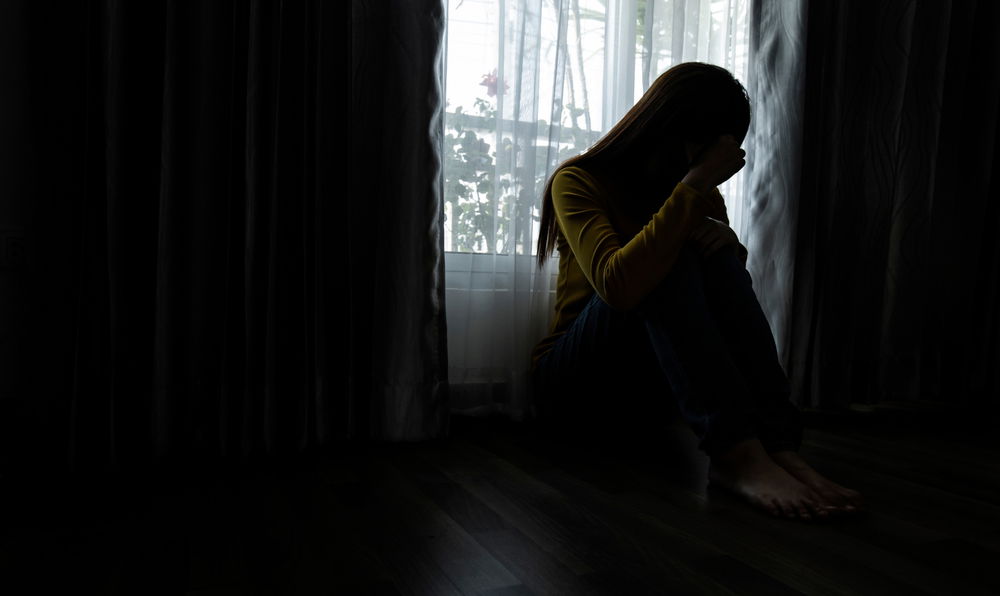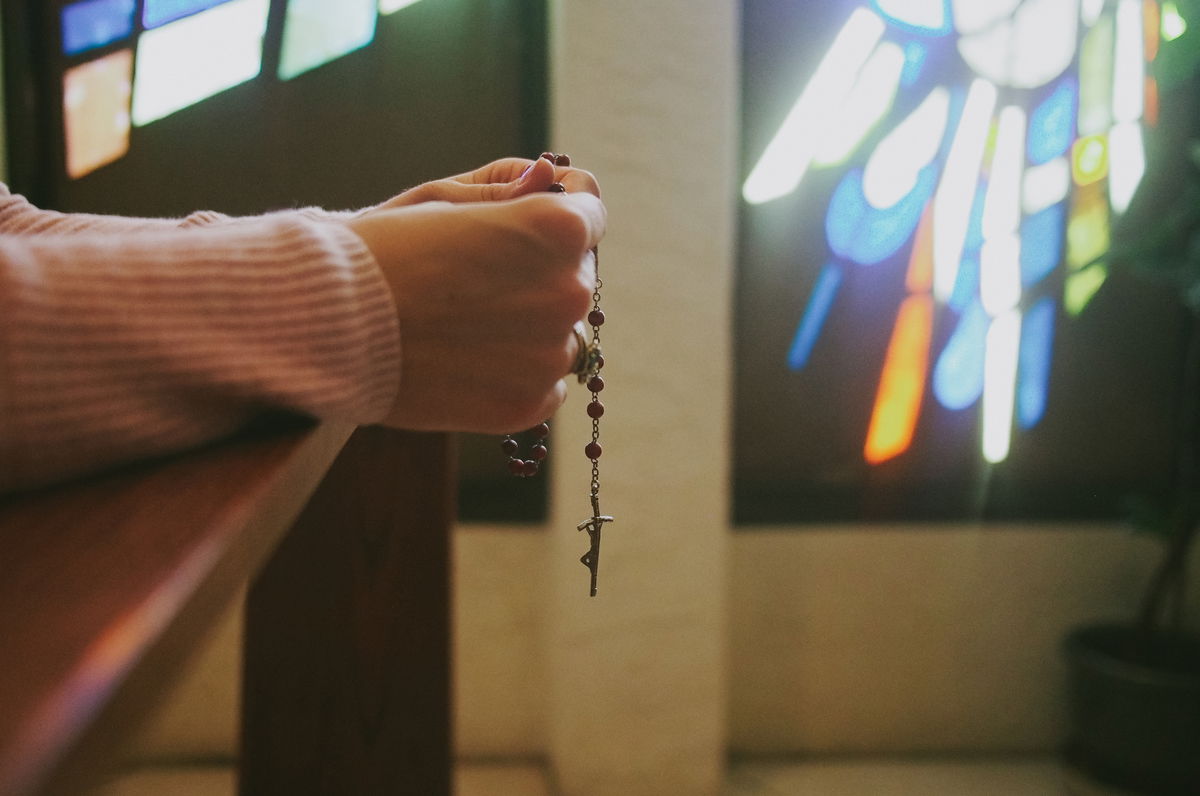Highlights
- The decline in religiosity across America in the 2000s and 2010s appears to be driven by a failure by parents to pass on the faith in the 1990s and 2000s. Post This
- Childhood, including before age 13, is the key battleground for religious formation. Post This
- Lyman Stone has our second most popular post of 2023. Post This
Editor's Note: Our second most popular post of 2023, with over 20,000 pageviews, is this August 2023 research brief from IFS research fellow Lyman Stone.
Religiosity in America has been in steady decline for several decades. However, in recent years, the pace at which Americans are leaving church behind has dramatically accelerated, as documented in the new book, The Great Dechurching, by evangelical pastors Jim Davis and Michael Graham, and sociologist of religion Ryan Burge. The book is based on a unique set of surveys describing and categorizing the various groups that have left American churches in the last few decades. The causes of this wave of dechurching are much debated, but The Great Dechurching devotes the vast majority of its attention to the experiences of adults, or most individuals transitioning into adulthood. In almost every single vignette in the book, people who lost their faith lost it as adults. Although one chapter near the end discusses parenting and childhood, it mostly does so in the context of describing what happens when children leave home. To read The Great Dechurching, one might suppose that Christianity is declining in America because adults, after considering a range of different concerns, decided church just wasn’t for them.
But by basing their book on retrospective surveys of adults, Davis, Graham, and Burge overlook one essential descriptive fact about religion in America: most of the decline in religion is actually among children, and virtually all of it among people under age 22. Secularization, or what they call “dechurching,” is happening among children and then trickling upwards into the general population as those children age. This essential fact suggests that any story of secularization in America has to begin with home life: what changed for children born in the 1980s and 1990s that they never fully absorbed religious belief as children?
Religious Belief Among Children in the Long Run
Surveys of children are rare. But at least two large cross-sectional surveys of children have asked about religion: the Monitoring the Future survey series since the 1970s, and a 2019 Pew survey of adolescents. Looking at Monitoring the Future’s long running question about how important religion is to teens shows two things: first, that kids tend to downrate how important religion is to them throughout high school and, second, that children have grown a lot less religious in recent decades (see Figure 1).1
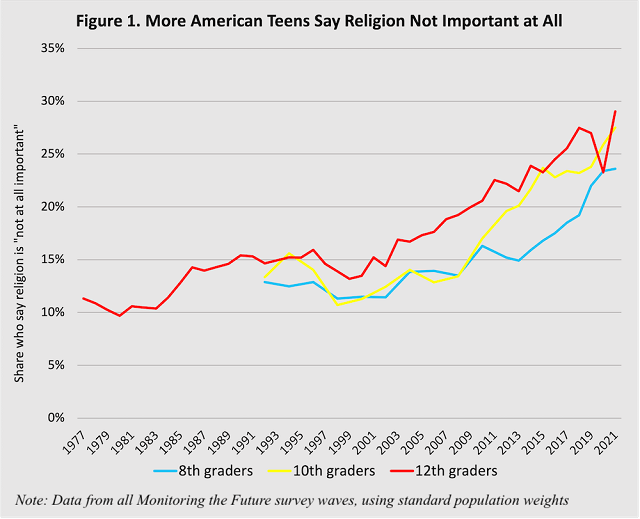
In every year since 1991, 12th graders were more likely to say religion was “not at all important” than 8th graders. Before 2010, 10th graders were very similar to 8th graders; but now, 10th graders are more similar to 12th graders. Lining up the data by birth cohorts instead of survey years, about 5-9% of kids shift into saying religion is “not at all important” to them between 8th and 10th grades. But even more striking, in 2021, almost a quarter of 8th graders said religion was of no importance to them.
Religious Belief Among Children and Parents
Could it be that child secularism is rising because parents are raising their children in a more secular way? It’s unlikely. A 2019 survey by the Pew Research Center surveyed parents and children about religion, including children ages 13 to 17. Figure 2 below shows the share of kids who said religion was “not at all important” at each age, as well as the share of parents of kids at each age who said religion was “not at all important” to their child. In other words, this graph compares what kids say about their own religion, and what parents say about their child’s religion.
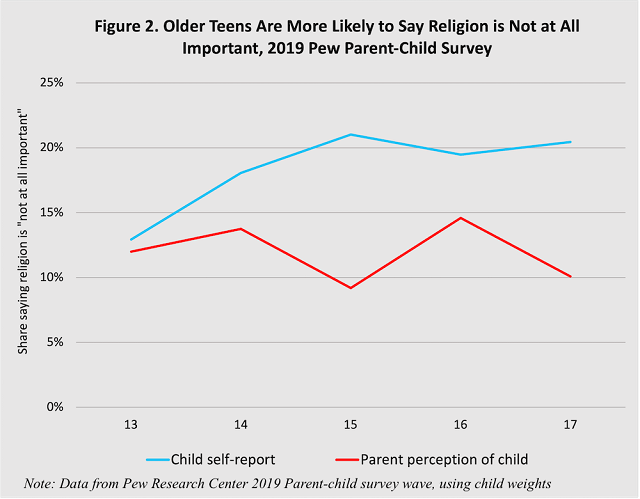
In this survey, there’s little change in child self-reported secularism between ages 15 and 17, but a big change between ages 13 and 15, similar to what was observed in the Monitoring the Future data for recent years. But only about 10-15% of parents say religion is “not at all important” in their child’s life, and there’s no change across age. As kids get older, they secularize in a way parents are not observing. Parents don’t perceive their child as being irreligious, when, in fact, their child has already lost their faith.
Longitudinal Data on Youth Religiosity
The Monitoring the Future survey, however, is cross-sectional. Using data from the National Longitudinal Survey of Youth 1997 cohort, we can follow the religion of young people born 1980-1986 until around age 30, to see if and when their religiosity changed. Figure 3 shows the share of these young people who said they had no religious affiliation.
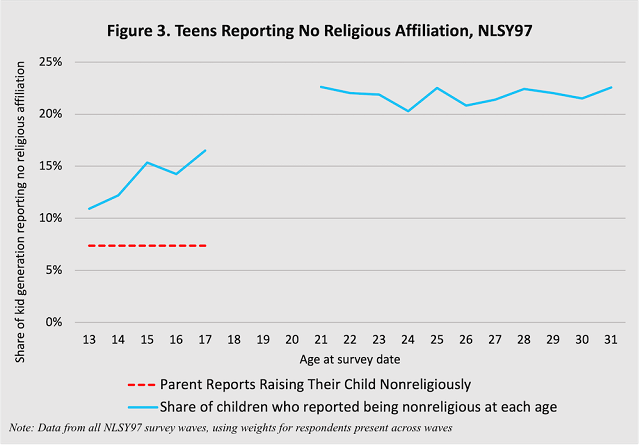
Of NLSY respondents surveyed at age 13, around 12% were nonreligious. By age 17, 17% were nonreligious. These children were surveyed in the late-1990s and early 2000s, and so it is a decent match to the MTF for those periods, strengthening confidence in its general reliability. Religious affiliation wasn’t surveyed for a few young adult years, but then by age 21, about 21-23% of these young people were nonreligious, a share that has been essentially unchanged until today. In other words, this cohorts’ rise in secularism occurred by age 21, and much of it by age 17. By comparison, the hashed line shows the share of parents of children ages 13-17 who reported that they were raising their child with no religion. Only 7% of parents said they were raising their child with religion, yet by age 13, 12% of kids were nonreligious, and by age 17, 17% were nonreligious. As with the Pew data, most nonreligious children are born into religious households and lose their faith while under the supervision of parents who believe that they are successfully transmitting their religious values.
Youth Secularization Accounts for Almost All Secularization
By now, it should be clear that childhood, including before age 13, is the key battleground for religious formation, not adulthood. By the time a child goes to college, much of the religious question has already been settled.
But it is worth zooming out to the general population to show that there really isn’t very much secularization of adults at all. Figure 4 shows several decadal birth cohorts in the General Social Survey, a survey of American adults reaching back to the 1970s. It shows for each decadal birth cohort what share at each age (18-20, 28-30, 45-50) “believed in God without a doubt.” This is a different metric than above, but it points to a similar dynamic of faith and religion.

There is virtually no change in religiosity across cohorts for individuals born in the 50s, 60s, and 70s: modest differences in given periods are generally not very significant or durable. For the 1980s birth cohort, there was some decline between early adulthood and ages 28 to 30, but not a great deal. But for the cohort born in the 1990s, they began as adults with a minority confident belief in God. Kids born in the 1990s didn’t lose their faith as adults; they had already lost it in childhood. There is little to no change in belief in God for 1990s kids between ages 18-20 and 28-30. In other words, the decline in religiosity we’ve seen across America in the 2000s and 2010s, and especially among young people, isn’t driven by a loss of faith among adults in that period. It appears to be driven by a failure by parents to pass on the faith in the 1990s and 2000s.
Conclusion
Secularization, or “dechurching,” in America is proceeding very swiftly, and almost entirely through simple generational replacement. Millennials are one of the largest birth cohorts in recent history or since, and their parents were uniquely unsuccessful at passing on their faith to their children. As a result, huge shares of young adults today had at least nominally religious upbringings, lost confidence in that religion sometime before age 22 and often before age 15, and now form a large mass of today’s nonreligious adults.
For religious people, and especially religious parents, this has several important takeaways. Children, even 16 and 17-year-olds, are usually not having extremely sophisticated apologetics-style arguments. The arguments that persuade children to believe things are not necessarily rationally coherent or compelling, and by the time people are old enough to fully absorb the content of religious debates (their 20s), they tend not to change religion. In other words, most of the rise in secularism in America probably doesn’t have much to do with any actual deficiency of rational arguments for religion, or strength of arguments against it.
Rather, loss of religion is about childhood socialization. School environments that prioritize career and never present religious vocation as an option, neighborhoods where churches are zoned out, churches preaching more political sermons than about the challenges of family and adolescence, the explosion of youth pornography usage, social media connecting young children to the social worlds of older children in a totally unsupervised platform, and so forth. The reality is that the last 30 years have seen a dramatic diminution of parental influence in general as kids spend more of their life in child care settings, at school, and online. This shift has protected them from some damaging influences (teens today do less drugs and have less premarital sex) but has also reduced the reach of some good influences (churches, parents).
For parents to keep their kids in the faith, they must recapture their influence. Shield children from schooling environments that relegate faith to a second-class topic, deny access to unsupervised online communities and pornography, and have daily, parent-led activities centered on family solidarity around shared faith. Families that do these things still have extremely high rates of successful religious transmission, but families who trust that children will “pick it up along the way” fail to transmit their religious beliefs, and suddenly find to their great surprise that their 20-something children categorically reject their faith.
While the argument that “dechurching” mostly happens to children is not completely at odds with the message of The Great Dechurching, it is not in lockstep either. Whereas Davis, Graham, and Burge see the main issue as a failure to incorporate young adults and thus “pass the baton,” actual data on childhood faith suggest the real failure occurs much earlier. They suggest that “older generations seem to assume that if they do the same things their parents did, their children will, as they did, make the church a priority,” but this is giving the parents of Millennials and Gen Z far too much credit. Those parents did not do the same things their parents did: they divorced at higher rates, gave their kids more screen time, let their children spend their whole childhood in almost totally secularized schools, and were far less likely to take their kids to church regularly. If the parents of the 1980s to 2000s had in fact discipled their children as well as their parents discipled them, churches today would likely have more young people. This fact must be confronted head on if churches want to faithfully engage with a dechurched society.
Lyman Stone is a Research Fellow at the Institute for Family Studies and Chief Information Officer of the population research firm Demographic Intelligence.
1. Figure 1 Note: Standard Monitoring the Future weights used. 2020 12th grade survey was unusual due to COVID-related interruptions.




